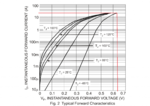vindhyachal
Newbie level 4
1. I have a application in which I have to pass 10A current through diodes, diode here is for reverse current protection.
Since total current is 10A, I have connected 4 diodes in parallel PDS1040.
2. Cannot use mosfet here since I have already had PCB made. So have to go with parallel diodes.
3. I was reading on internet that if a series resistor in front of diode is connected & diode current can be shared equally between each other.
4. I want to know how to calculate this resistor value. What is formula used here.
5. Again please dont mentioned other sol like mosfet since I have already made PCB with 4 parallel diodes & 4 series resistor space in front of each of them.
6. Attached is If vs Vf of PDS1040.

Since total current is 10A, I have connected 4 diodes in parallel PDS1040.
2. Cannot use mosfet here since I have already had PCB made. So have to go with parallel diodes.
3. I was reading on internet that if a series resistor in front of diode is connected & diode current can be shared equally between each other.
4. I want to know how to calculate this resistor value. What is formula used here.
5. Again please dont mentioned other sol like mosfet since I have already made PCB with 4 parallel diodes & 4 series resistor space in front of each of them.
6. Attached is If vs Vf of PDS1040.
